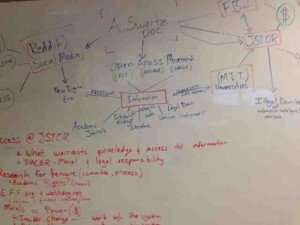This has been a provocative and challenging week for the hopes and dreams of an open and meaningful web. And while the provocations raised are by no means new, there is something in the air that feels more urgent, more in need of our attention. How timely that our Connected Courses work is focused on trust and network fluency in light of the very real, powerful, and material stories that have emerged in the past several weeks. The stories of Kathy Sierra, Anita Sarkeesian, and Julie Pagano have collided and created an opportunity to ask ourselves: what kind of world (virtual or analog) do we want to live in? And how do we protect these worlds and the people in them?
In case you have not been following these stories, all of the women have been harassed, threatened, and ridiculed. Sometimes they are not believed. Sometimes they have actual death threats levied against them. The powerful (and upsetting) stories from Kathy, Julie, and Anita (among countless others) in tech raise a hundred questions for me: How do we protect an open web and protect people who are vulnerable in an open web? Are the very “fixes” we might imagine for solving the human element of the open web antithetical to an open web? How do we move from this adolescent stage of the web to a grown up and healthy version of this space and of ourselves? And how will we ever get better at creating environments of trust and respect if the comment sections of our blogs and twitter accounts and other virtual spaces are the most vulnerable to attack? How do we honor dialogue when it has the potential to do such harm?
I have always been an advocate for open: open teaching, open web, open open open. I share resources, freely, ask my students to blog and tweet without fear, and ultimately gain even more from the generous sharing from colleagues. I’ve also carefully followed SOPA, PIPA, Net Neutrality debates, Aaron Swartz’ story, and tried to do my part to support causes dear to the open web movement. These things matter. Most of us truly believe that you must change structures and systems (institutional, platform or otherwise) if you want to effect real change. As Rafi Santo has argued, ideologies are built in to systems and we must hack them for the better.
But how do we make systems safer while still valuing an open web? How have we ever been able to account for the worst of human nature? How do we help people grow up with the web?
These issues have resonated with me even more than usual for a variety of reasons, both personally and professionally. Professionally, as I open up my classrooms to more vulnerable populations–like the amazing 8th graders my students and I are blogging with–I am hyper aware of the need to protect our students and colleagues and still create a space where their ideas matter and can be heard. I am carefully reading through the resources Mimi Ito recently shared in her blog post and considering the stories and ideas being shared by others in our Connected Course; recent posts by Kevin Hodgson and Jenny Mackness are incredibly insightful. And I am grateful to Kira and Jonathan for raising such important ideas in our work together.
I hope to take all these powerful cases and use them to imagine a world where trust and openness thrive on the web. As Sarkeesian asks at the end of her talk, when we tell our stories “trust and believe.”
Let’s discuss. And act. And be better humans.
Anita Sarkeesian’s talk from the recent XOXO Festival
Overview of the Gamer Gate controversy here
Kathy Sierra’s powerful post from Tuesday: Trouble at the Koolaid Point
Julie Pagano’s original post: Death by 1000 Paper Cuts (she has since updated here with a series of posts about the Life and Times of a Tech Feminist Killjoy)
And Kevin Hodgson’s post from last week and all the great comments that follow: “When Trust Gets Breached…”


